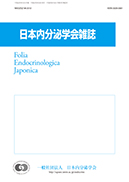All issues

Volume 67 (1991)
- Issue 12 Pages 1295-
- Issue 11 Pages 1231-
- Issue 10 Pages 1147-
- Issue 9 Pages 14-
- Issue 8 Pages 811-
- Issue 7 Pages 755-
- Issue 6 Pages 655-
- Issue 5 Pages 587-
- Issue 4 Pages 19-
- Issue 3 Pages 175-
- Issue 2 Pages 57-
- Issue 1 Pages 1-
- Issue Supplement-3 Pa・・・
- Issue Supplement-2 Pa・・・
- Issue Supplement-1 Pa・・・
Predecessor
Volume 39, Issue 9
Displaying 1-3 of 3 articles from this issue
- |<
- <
- 1
- >
- >|
-
1963 Volume 39 Issue 9 Pages 797-841
Published: December 20, 1963
Released on J-STAGE: September 24, 2012
JOURNAL FREE ACCESSDownload PDF (4815K) -
Satoru OTA1963 Volume 39 Issue 9 Pages 842-862,795
Published: December 20, 1963
Released on J-STAGE: September 24, 2012
JOURNAL FREE ACCESSCorticosteroid biosynthesis in the different cellular zones of beef adrenal cortex was studied in vitro.
Various substrates including acetate, cholesterol, pregnenolone, progesterone, desoxycorticosterone, and desoxycortisol were incubated separately with homogenates of fasciculata-reticularis tissue and with slices of glomerulosa tissue.
Although the following sequences were demonstrated in the adrenal cortex, the results of this experiment indicate the absence of 17α-hydroxylase in the zona glomerulosa and the absence of 18-hydroxylase in the zona fasciculata and zona reticulalis.
Aldosterone
Pregnenolone Progesterone Desoxycorticosterone Corticosterone
17-α-hydroxy-Desoxycortisol progesterone
Incubation of acetate or cholesterol with homogenates or slices of adrenal cortex, however, did not lead to the increase of corticosteroid.
In addition, the incubation of adrenal cortex without substrate resulted in the formation of considerable cortisol and corticosterone, while no cholesterol-route intermediates were detectable in the adrenal homogenates. When the dializate of the adrenal cortex against buffer was lyophilized and incubated with adrenal homogenates, it caused a remarkable increase in the production of corticosteroids. This may be due to the conversion of the dialized precursors to corticosteroids, though these precursors have not yet been isolated.
17α-hydroxylase activities were also demonstrated in the homogenates of HCG-treated-rat testis and in the slices of normal adult human ovaries. These tissues were incubated with 3H-Progesterone and the formation of 17α-hydroxyprogesterone-3H was clearly demonstrated.
The incubation of full term human placenta with 3H-Progesterone, however, did not result in the formation of neither 17α-hydroxyprogesterone nor phenolic steroids.
From these results, it was suggested that, in human placenta, there is a dominant pathway by which dehydroepiandrosterone is formed from cholesterol, not through progesterone, but possibly by the direct cleavage of the side chain C-17 and C-20 ; and dehydroepiandrosterone thus produced in turn converts into Δ4-androstene-3, 17-dione and testosterone, and then to estrogens.View full abstractDownload PDF (4098K) -
Zoroku ARAKI1963 Volume 39 Issue 9 Pages 863-881,796
Published: December 20, 1963
Released on J-STAGE: September 24, 2012
JOURNAL FREE ACCESSWith the use of paper chromatography, analytic studies on the character of sugar and the composition of amino acids contained in the thyrotropic hormone (TSH) and gonadotropin were made.
I. Composition of the sugars in TSH and Gonadotropin.
(a) Spectrophotometric analysis of Pretiron was made by hydrolizing two hours with NHCl 10cc. It was revealed that aldo-hexose and several other substances were present. Further serial electrophoretic examination showed that it was possible to obtain two fractions, one fraction possessed of active biologic substances and the other without such fraction.
The paperchromatographic examination of respective fraction showed that galactose and glucosamine were detectable in the biologically active portion and no galactose could be found in the non-biologically active fraction.
(b) The sugars in gonadotropin were similarly examined as tried in TSH. Galactose was also found in respective biologically active fraction. It has been proved that both TSH and gonadotropin contained galactose in the biologically active fractions but none could be found in non-active fraction when sugar content of the two hormones were compared.
II. Amino acids in TSH.
A TSH active fraction of the anterior pituitary was analized with high voltage electrophoretic method after 18-20 hour hydrolysis with 6 NHCl and fractionated into basic, acid and neutral amino acids. Further analysis of the fractionated amino acids was made by means of secondary paper chromatographic separaton. Eighteen different kinds of amino acids beginning with isoleucine and leucine have been isolated and quantitative analysis of respective composition of amino acid was made with DNP.
Comparative studies of amino acid formation and gonadotropin which closely resemble TSH as far as elements go, have revealed that the kinds of amino acids contained were identically the same though quantitatively different. From the above results, it is assumed that the galactose found in biologically active fraction of TSH and gonadotropin are common, and the amino acids found were no different though some quantitative variation had been observed. The author has assumed that the chemical nature of TSH and gonadotropin closely resemble in their glycoprotein characteristics.View full abstractDownload PDF (1975K)
- |<
- <
- 1
- >
- >|